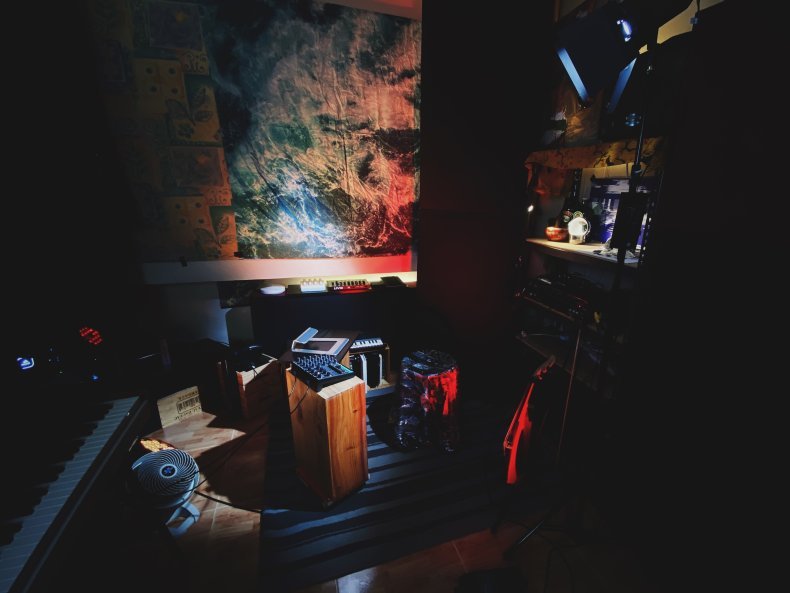Link to slides here!
Author: Wei Lin
Interactive Environments – Spider Lily Room
NGS Visit Review – Time Passes, Blue Trapezium
Both exhibitions, An Exercise of Meaning in a Glitch Season and Time Passes, were extremely interesting and eye-opening for me. There a variety of mediums, as well as a large range of ideas brought up in the entire exhibition through many works. It was a good experience seeing how certain materials were used and manipulated into works of art, and how many of them mixed traditional and digital into a cohesive project. It was interesting to hear how the curators chose the works, and the problems they faced in the exhibition set up process.
All the works were well-thought out and gave food for thought. It opened my horizons to the art scene in Singapore, and made me realise the amount of unique and brilliant artists there are in Singapore. It was fun to see some works bring in the Singapore context, with works relating back to places we live or things we use. At the same time, many works also touch on issues on a global level, as well as personal level.
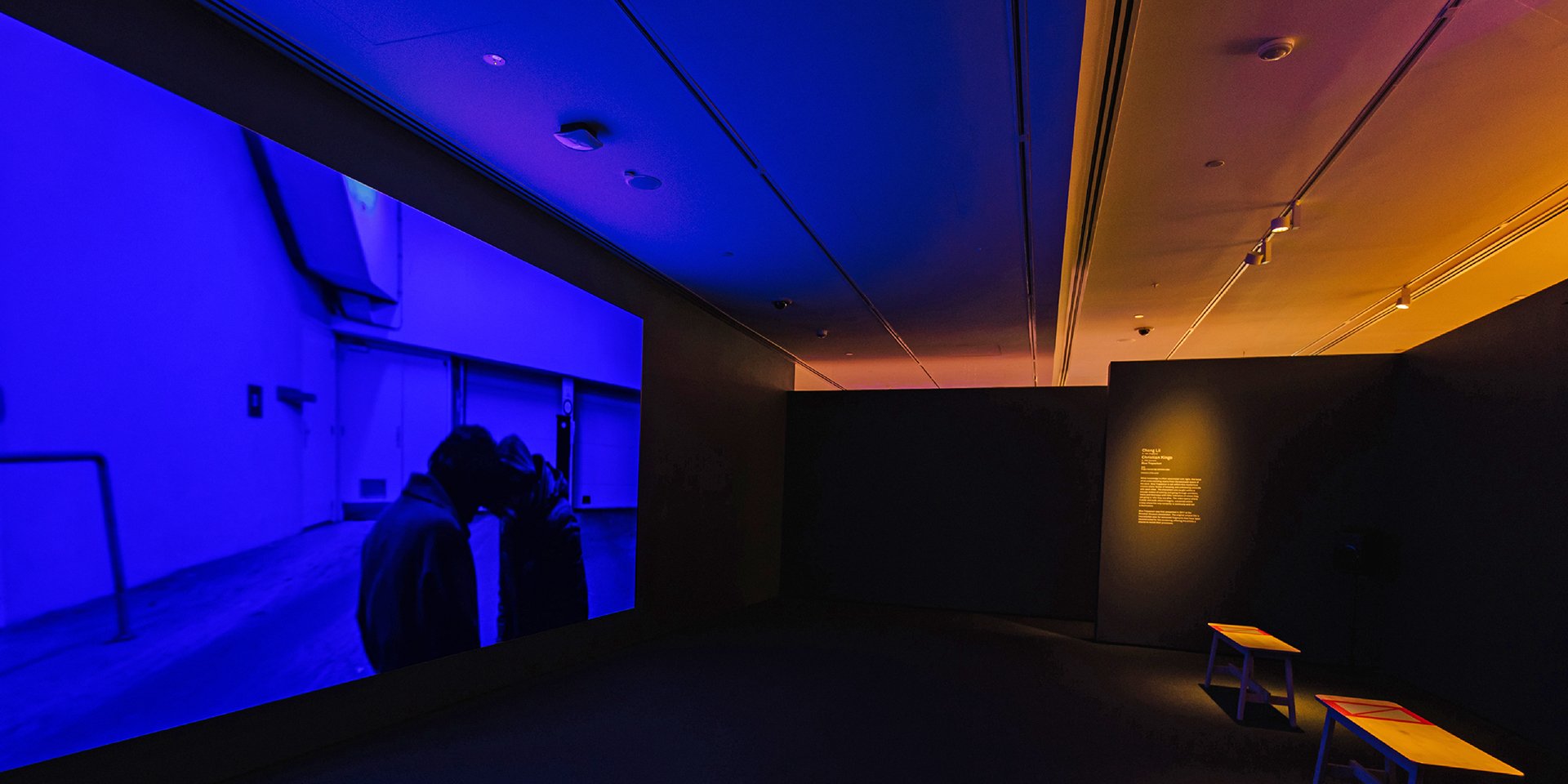
Among all the works presented, one work that really caught my attention was Blue Trapezium by Chong Lii and Christian Kingo in Time Passes. It is a 30 minute HD video, projected onto the wall. Opposite the projection are 3 seats, with speakers on each side. The area is dark, and is found hidden behind the exhibition’s description wall, unlike the other works that are openly displayed. The work being separated from other works allows the viewers to be fully immersed in the film, as they sit in the dimly lit screening area.
The reason why I chose this work was because of how I was so absorbed into the work when I watched it. More often than not, while I was amazed by works, I often still felt more like a person watching from the outside, in a sense that it was me realising how I was supposed to feel from watching it rather than feeling that emotion itself. Yet, for this work, it truly tapped into my mind, and made me feel things I never expected to.
Blue Trapezium is a film that, based on the Singapore Art Museum’s audio tour, :
“…explores the peculiar location and role of the brain in every human body. Knowledge is often referred to as the “light” that dispels darkness. Yet, this knowledge, or ability to understand, is located in the “dark” crevices of the brain, which itself resides in the enclosed space of the skull. It is from this location that physical actions and mental processes are initiated for all humans. However, each individual has their own unique perception, memories, and interpretations. Blue Trapeziumis set in a nowhere place. We follow the characters in the film as they move through hallways, doorways, television screens, indoor and outdoor spaces. The characters flow in and out without a link to each other and with no clear story line. There is a fragmented, endlessly shifting context, while the sounds, colour, pauses and pace of the narratives add to the elastic space created in the artwork.”
True enough, as I watch the scenes in the film, they do not make any narrative sense, and feels as though they are cuts of different videos pieced together. Some scenes feel as though I am watching a film or movie, while others feel like a memory, or a vision. Some scenes in particular really moved my heart and mind as I sat there for about 10 minutes just watching the film.
One was of a person next to a window being lit by passing neon lights as loud classical music played in the background. The scene was ethereal and brought memories back of when I sat in trains or buses for long periods of time, listening to music from an earpiece, blocking out any other sounds. The feeling of being detached from the world, watching it pass by, was quickly brought out from the depths of my mind as I saw the scene. The fact that the video could touch memories and feelings so specific within us was extremely incredible and I felt the film managed to achieve what they aimed for.
Another scene was of a lady walking through a corridor with flickering lights. This paired with the dim lit projection area was a unique combination that aided in the effect it had been trying to give. As the lady walked “towards us” in the film, the lights suddenly went fully out. Sitting alone in the area watching the film, the sudden darkness caught me off guard and I loved the idea of the film feeling so alive and how I felt I could connect with a video that displayed on a flat wall.
The film continues to show different scenes that trigger memories and feelings from within the mind, making it an extremely captivating and engaging video.
Likewise, in the works that I make, I hope to achieve the effect that the film was able to do. Using interactive elements, combined with my product design, I hope to make works that can reach deep into the minds of people. I do hope to continue learning more about the human mind and brain, and study how we think and act.
About the Artists
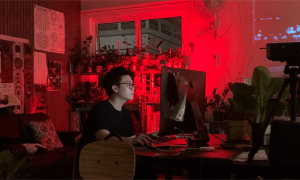
Chong Lii is a Singapore artist who studied in the Gerrit Rietveld Academie of Amsterdam, New Zealand.
Chong Lii’s work aims to explore the possibility of merging or levelling disparate spaces, objects, people, and images. Permeable frames of history and ontology are set against the spectacle of fiction, re-articulating the sociopolitical tensions from which these elements arise.
Singaporean millennial fantasies, accidental occult tributes in digital media and imagined historical subcultures are among the subjects filtered through an idiosyncratic gaze that supports and undermines them in equal measure. Operating alongside strategies of complicity and dissent, his installations and films simultaneously counter and revel within the apparatus of the moving image.
Christian Kingo (b. 1993) is a Danish filmmaker born and currently based in Copenhagen. Contemplating notions of belonging, his work investigates subjects of cosmopolitism, nostalgia and the domestic. These concerns are reshaped by elements from science fiction and horror, rendering narratives within disorienting environments. Grounded by traditions of cinema whilst pushing to defy its genres and formats, Christian works primarily in video & sound installation, live sound performance and film.
Singapore Art Week Review – Shifting Between
Exhibit Chosen: Shifting Between
Location: Gillman Barracks
Our Softest Hour presents Shifting Between – a group exhibition that plays on the seams of the digital and physical as the works weave together an online and offline experience. Through these two realms, participating artists Clarice Ng, Divaagar, MACHINEOFTHE, nor, Softslabs. and Planeswalker invite audiences to explore the shifts in how they engage with and experience intimacy and vulnerability.
Throughout the week, each artist will be joined by founders of alternative art spaces in Singapore for an artist talk.
Exhibition Visit and Review, done with Sylvia Low!
Shifting Between’s website can be accessed here.
Link to slides.
Thoughts on CH 1 from Kim Goodwin, Designing for the Digital Age
Being a product and interactive design student, I found that this chapter was extremely useful in summing up the process needed to create a well-developed and polished product. It took the years of lessons from my teachers and neatly described what we as product designers strive for and how we pave the road to the goal. It is definitely something all designers should read and aim to follow.
For design to be design and not art, it must serve human needs and goals.
Indeed, design is made with people’s wants and needs in mind, and the end goal is to create something that can meet their demands. This sentence made me think of an interesting mindset I had recently changed to.
More often than not, we may see the people’s wants as something that is more related to numbers and statistics, something that requires improved technology or a groundbreaking invention, but we must open our eyes to also see that sometimes their demands may come in a more emotional, fun way.
Before I had finally understood what it meant to design, my peers and I used to joke about how some of our products had no actual value and were just for users to have fun or for aesthetic value. It took me rather long to realise creating a fun product also had its benefits for the user – to enjoy themselves and have a good time. This was the value for my product, and I should not limit myself to thinking that value only came in the form of tangible outcomes.
I would consider designing a fun product Design and not Art as while it does indeed refer to more non-essential creations, I would say it is made with the idea of solving people’s need for fun and joy, rather than the creator’s personal expression of their thoughts and ideas. In this case, I would call it a fusion of art into design.
Design is the craft of visualising concrete solutions that serve human needs and goals within certain constraints
As the reading says, whether it be industrial design or lifestyle design, the aim is to find the optimal solution into helping the users achieve their goal. As designers, we must aim to create something that targets the problem as best they can, or improve existing products.
While we sometimes feel restricted by our knowledge, as long as we see the potential end goal clearly, we can articulate the things needed to external experts that will aid in achieving that goal. We must always be aware that we are not alone in the entire creation process, and must mainly learn to carry across points to other parties of the project. Sometimes one may be highly skilled in various technical areas, but with no vision, it would be difficult to solve the problem effectively. This can be connected with the next phrase:
Design is a craft because it is neither science nor art, but somewhere in between
This is an interesting sentence, and does resonate deeply.
Consider a product design assignment, where the brief is to create a new design for an existing household item, one may think we simply need to create a new look for the item. Afterall, the technology exists and is already well made. Yet, we may fail to realise that to create a new look, we have to become experts in the creation process of the item quickly, to ensure the final design can not only house all the necessary components, but also be comfortable for the user to use. This includes the technology the item uses, the size of the components, materials, and even the machinery needed to create the item must be put into consideration. All this is paired with thinking of how users would hold the object, keep it, are there room for them to misunderstand the use of a part.
It seems as though we require multiple facets of the entire process to come up with a single best design that looks simple to create yet took immeasurable considerations and information to complete. Design is the compilation of thousands of pieces of information, cleanly sorted and artistically arranged to form a final product that looks effortless and beautiful. The balance of art and science here has to be perfect to create the best outcome and perhaps that is why design is fun yet doubtlessly difficult. Nevertheless, it is the satisfaction when our work meets the demands of people that most probably attracts designers into continuing the pursuit of the perfect solution.
Experience Design – No designer can determine exactly what experience someone has
I agree with this statement strongly. Thus, we are often told to consider the affordance of the product we create in product design. In other words, how might others view the object and what might they mistakenly do or interpret. In other words, we must think of all the possibilities that may occur when someone interacts with the product we create, and ensure it is safe and still serves in function.
Apart from that, we must also think of who the target audiences are. If made for the mass, then one must be sure it is suitable for the young and old to use. Products designed must be inclusive and consider all parties involved. The handicapped, the elderly, children, etc.
In the Origins of Goal-Directed Design segment of the reading, Alan Coopers creation of Aunt Edna is hence ingenious and perhaps is something all designers should adopt.
Often times, we tend to be so absorbed in our idea that we may not realise the idea is clear in our minds but not properly articulated or expressed in the design. While we may think something is obvious in the design we made, other who have never seen it before may be confused or lost. These are things to take note for every project to ensure the usability of the product.
Overall
Kim Goodwin goes on to talk about the components of goal-directed design, which are great points that I will definitely aim to apply to all my design works.
The reading was insightful as it helped me to see my main purpose in the creation process. Occasionally I may feel restricted by my knowledge, but it is important for me to realise that with a clear solution and idea in mind, I can get help from external experts to achieve my goal. Hence, I must always ensure that my designs are well articulated and most of all, meet the purpose of creating that product to begin with.
While I do think about these in my product design works, perhaps I should begin to apply it to Interactive Media too, and see how I may improve the works I create.
Thoughts on Social Practice Arts
Art can certainly change the life of one person who had been deeply impacted by an artwork, yet, I highly doubt art would be able to solve poverty or world hunger within a single exhibit. If such a thing was possible, no doubt we would already be living in a world of pure peace and joy; an oasis.
While I do appreciate and enjoy viewing works related to social practice, I always preferred not doing works of such kind. As such, this article truly resonated with me, and made me think deeper into the reasons why I may have avoided these topics.
To me, art is something more personal and less about the whole world, to put it in a bad way, something more selfish and self-gratifying. In other words, whether the topic be about one’s self or world issues, it stems from the artist’s own feelings for the topic, and it would be seen in a more extravagant light. Perhaps one may argue everyone in the world is doing things based on their own personal agendas, and that I do concede, but what differentiates art from science is the mundane, systematic, raw data and facts from science, as compared to what art may bring – a more aesthetically based, potentially-biased, emotional level of work.
I think this view of what art is influences the way I see social practice art, which on occasion seems to attempt to make changes that in my personal opinion would require a more dire solution which is built on a more solid foundation compared to one that also puts half the attention on the overall look and experience of the solution. What I mean to say is, perhaps trying to solve world issues such as homelessness is not as easy as building a row of houses by artists.
The Project Row Houses by Rick Lowe sounds like an amazing project, yet, as said in the article, it had failed to solve the problem it had aimed to solve. Instead, the situation had gone worse and yet they were praised worldwide.
Is this strand of art a starting point for addressing social problems, or a distraction that keeps us from seeing their true extent?
True enough, one would begin to wonder if those who heard of the Project Row Houses began to research and start to help the homeless more. Or if the government had taken action after the project. Or… Did they sing praises of the project, get amazed by the collaboration of artists doing a “good cause”, and then think the whole problem magically disappeared just from building a few houses?
I do agree this may be a negative way to think of things, yet, I believe the effect of such one shot projects may make others believe the situation is easier to solve than it is. Such projects have been done out of goodwill, yet, it perhaps is also done in rose-coloured glasses, where the artist themselves also truly believe their artwork may make a huge difference. However, reality may not be the case and there may be other factors that people fail to recognise in such big lasting problems.
Reading about Project Row Houses was amusing as, interestingly enough, I had considered doing something similar. While I may speak harsh words of the social practice arts, I would be lying if I were to say I had never thought of doing an impactful work that could help the lives of many. Yet, this beautiful thought is naive, and my eyes were opened by a friend I spoke to, who often did volunteer work to help the homeless.
I had proposed to her about the possibility of creating tiny homes in Singapore to help the homeless. As a product designer myself, I wanted to create space saving and multifunctional furniture, that could help save space while being affordable, thus creating a HDB of sorts made of small apartments for the homeless. In turn, she told me that it was not so easy to solve the issue. The homeless in Singapore had varying problems and reasons for them being homeless. Some did have homes to return to, yet found more company among the homeless, some just wanted someone to chat with, which was what their organisation did, but would reject any more help. More pressing, the government would highly reject the idea, as it would be seen as an encouragement for more to leave their homes, and instead seek shelter at the tiny homes.
Shamefully, I realised my mindset had been too shallow, and likewise to Rick Lowe, maybe we have failed to consider firstly, the true reason for homelessness and how to solve it, secondly, the other parties involved in this “art project” (the government and the homeless themselves), and finally the implications and possible outcomes of the project.
Yet, upon research on how to truly solve the problem, it would seem the solutions often involve education sectors, the government, and other parties that the arts would have little relation to. However, going in depth on the situation and looking at the pragmatic ways to solve it, it would no longer really be an “art” with a more beautified take on the topic. Which brings us to:
The very fact that “social practice” focuses on tangible issues means that, quite often, its aesthetic aspect is downplayed.
In this scenario, following my idea of what art is, I would no longer consider this “art”, but rather just social work (focusing on the issue rather than the aesthetics), that is made pretty. Not to say that it becomes less important or less valuable, but it would not be classified under art in my definitions.
Of course, that is not to say that the arts have no place in social issues. Social practice art yields a very positive outcome for topics that are focusing mainly on awareness. For topics such as domestic abuse, sexual harassment (both men and women), LGBTQ, etc, the arts can play a large role in helping those facing the fear to speak out, or the fear to allow themselves be who they are. For example, it had been thanks to the increased awareness of sexual harassment cases that many victims finally feel safer to voice their own experiences and get the help and comfort they need. In these situations, no doubt the arts may help open up conversations on these sensitive topics, and help people understand what it feels like to be in the victim’s shoes, creating a more compassionate society.
In other words, it seems there is a limit on when social practice art is highly beneficial. It may instead cause misconceptions and downplay of the severity of issues at hand, only looking at the issue superficially. Artists must know how to carefully thread on these lines, and ensure they view the problem in an all-rounded unbiased way.
Dev & Planning – Week 1 Assignment (About Me)
1. Biography
My name is Tjoa Wei Lin, a Year 3 Product Design and Interactive Media student in the School of Art, Design and Media in Nanyang Technological University, looking for job opportunities in this field.
My passion lies in making functional artisan works, fusing form and function to create a well-rounded work. Being keen in creating highly conceptual works, I have a strong interest in exploring topics surrounding human nature and behaviour, usually creating intimate projects that are in relation to human presence and mind.
To accomplish my goals, I have refined skills such as model making, computer aided design rendering and worked with multiple software. These software include Unity, Processing, Arduino and HTML.
2. Link to Presentation Slides
Slides here!

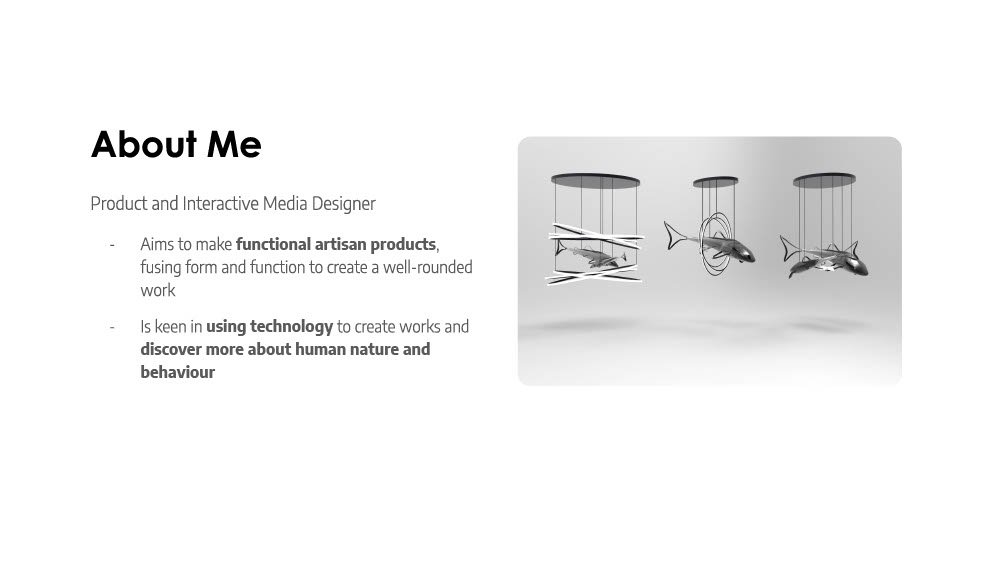
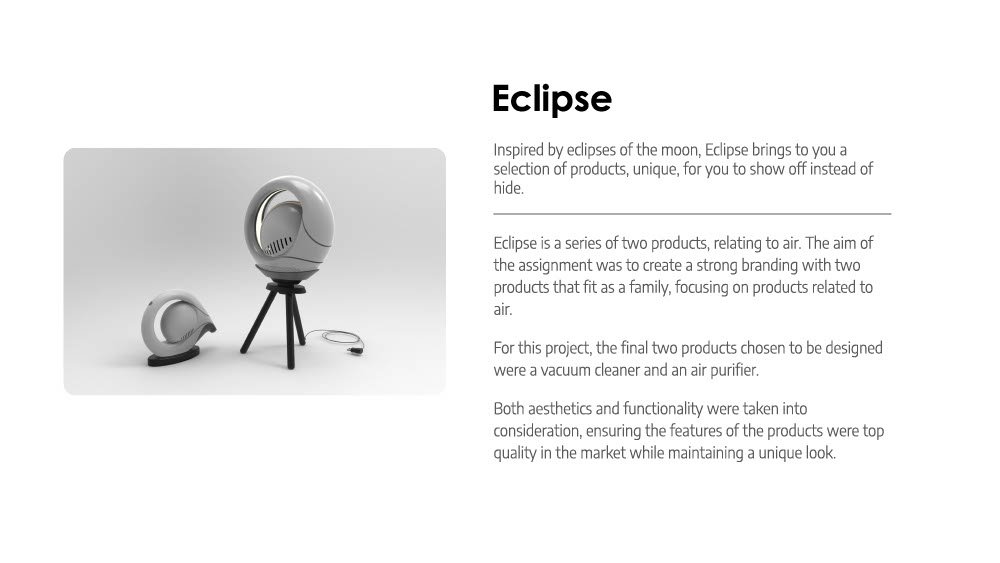
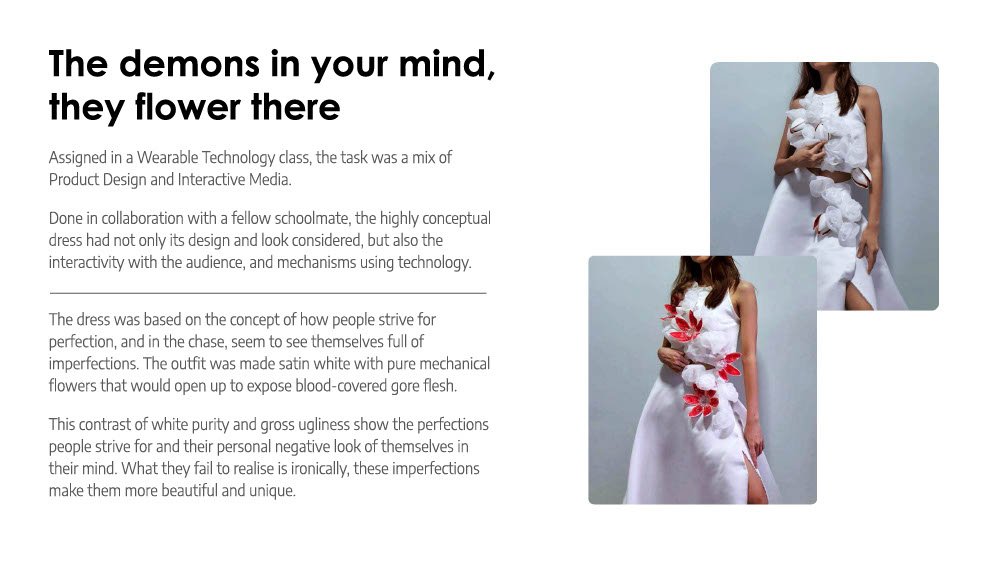
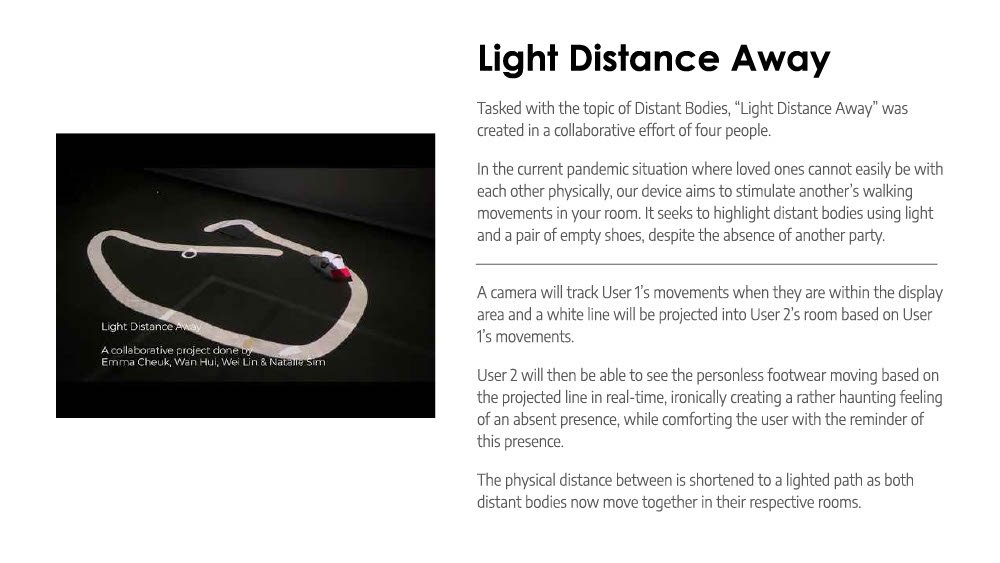

3. Resume
Download my Resume here!
4. Inspiration
Slides on Alex Davies
Link to Alex Davies Site
Sketch – Speculative/Provotype
Idea 1:
DOW Health: Sensimed Triggerfish
Speculative Design
Idea:
In future, eye check ups can be done by online ordered contact lenses/store bought lenses, that help to check one’s degree and eye health. Data can be assessed through a site that allows users to view their results. Should anything unusual arise, one can send their data to an eye specialist to receive feedback or notification if they need further physical check ups.
The item is a pair of contacts with sensors and detectors, packaged neatly in box. Users can easily purchase them, sparing them the trouble of having to go to an optical shop to get check ups. In addition to being to tell one’s degree, one will also be able to check their eyes for any problems such as cataract or glaucoma.

How to use:
When wanting to check one’s eyesight or eye health, simply order it online to get it delivered to your home, or go to a nearby clinic to purchase a set of these contacts.
Put on the contacts and wear them for a couple of hours to allow it to gather the essential data it need to help the user. If the user has degrees, they would need to wear spectacles for the day.
After wearing them, one can access their data through the QR code on the box, and then typing in a code for each special pair of lenses to get their individual data.
Should anything arise, they may choose to contact a specialist and book and appointment.

This device allows users to basically check their eyes while continuing their usual daily lives, without anything seeming out of place apart from some who have to wear glasses for the duration. It would be a new step into the future where most things, such as check-ups, are integrated into our lives seamlessly, with little disturbance to the usual activities of one’s day.
People can do check ups anywhere they like, easily, and as mentioned in my post for the DOW, medicine may also end up being distributed in the same seamless way.
Idea 2:
Provotype & Speculative
Idea:
Prosthetic or Limb Sleeve that make u move the opposite of where you want to go to, changing our usual intuitive movements to one we have to make a conscious effort to do. It is meant to be an annoying device, but also serves as an interesting experience in allowing users to feel how it is like to not be able to move their limbs without much thought. Users have to take time to learn how to walk again, like how prosthetic users usually require large amounts of time to get used to their prosthetic.
The device is a simple glove to be worn tight-fittingly, with sensors at the essential points to move the users arms with neuromuscular electrical stimulation. A headband with sensors attached will also worn by the user to note how they initially intended to move, so that the device may make them move otherwise.

How to use:
Users will wear the sleeve and the headgear, then just “move around as they would like to”, though the device funnily prevents them from doing that exact same thing.

This device is not only made on provotype grounds, but also speculative design, as I am unsure if there currently are means to do this with quick and instant relay. The device has to capture the intended movement of the user and instantly send pulses to go the other way. One potential way is to train the device the different pulses needed to move in a certain direction and call these pulses when the user’s neural messages say to go a particular direction.
DOW Senses: SensArs’ SENSY

Made to help amputees feel again from their missing limbs, SENSY from SensArs is a interesting prosthetic device available worldwide, made to restore life-like sensory feedback from the prosthesis of amputees or from the limb of patients with damages to the peripheral nerves. The neuroprosthetic is implanted within the residual nerves of the amputees, or the healthy part of their nerves to restore the natural flow of the neural sensory information.
Those who have lost their limbs in unfortunate events would thus be able to return a bit more to their previous way of living, perhaps easing them slightly from the mental and body fatigue of their accidents. This also helps subjects feel more natural again, tackling the problem of the phantom limb syndrome that may possibly arise. Over the course of a one-month therapy program with neurostimulation, scientists managed to considerably reduce phantom limb pain in one of the patients who complained of having it and in the other, the pain disappeared completely.
The prosthetic leg device, SENSY, is able to sense various parts such as foot touch, pressure, and knee joint angle with its external sensors. These sensed signals are then transmitted back to the nervous system using a set of stimulation electrodes implanted into the tibial nerve.

SENSY consists of an implantable intraneural electrode for sensory nerve stimulation, an implantable stimulator and an external smart controller. This smart controller, which is the “brain of the system” can be connected to the sensors embedded in the prosthesis or to a sensorized glove or sock, and receives information from the prosthesis and transduces it in the language of the nervous system, instructions of stimulation, which it sends to the implantable stimulator.
In other words, Artificial sensors are implanted to connect to intact nerves, stimulating response in the brain as if there was an intact nerve in a limb. The sensors are connect to wires simulating an actual nerve, and those wires are implanted and connected to actual nerves within the body. Between the artificial sensors and the residual nerve is an implantable neurostimulator which is bidirectional, sending and receiving signals from both the intact nerve and the artificial sensors.
The device was created with several options of usage:
- Being simply a sort of neural sensory pacemaker if the user does not have prosthetics
- an excitable device like a sensor which also sends a signal to the nerve.
- Being a sensorized prosthetic
- Being a sensorized glove or sock over intact limbs but with nerve damage
- These socks and gloves contain sensors within the fabric which act essentially as sensitized skin, also sending signals to an implanted device which communicates with the intact nerves
To make this device, the scientists tested attached tactile sensors to the sole of commercially available prosthetic feet, and collected knee movement data. They then placed tiny electrodes in volunteers’ thighs, connecting them to residual leg nerves, trying to introduce eletrodes inside the nerve to allow the restoration of a more natural sensory feedback.
The research team then made algorithms to translate information from their sensors into current impulses that the nervous system reads, delivering them to the residual nerve. The signals from the residual nerves are conveyed to the person’s brain, which is thus able to sense the prosthesis and helps the user to adjust their manner of walking accordingly.
From the test they received positive feedback from volunteers of the device, with many mentioning it was less mentally strenuous to use and also gave patients more confidence in themselves.
PROS:
I think the device is good as it gives those who have unfortunately lost a limb a chance to return to the way of living before their accident. Those who have lost their limbs in accidents most probably face the stress of losing a limb they were previously reliant on, and now, instead of having to change their entire lifestyle, they could still continue the path they were moving on. Usual prosthetics may help in providing some comfort by helping the users in feeling whole again but it may also go so far, as the senses in the lost limb are not felt by the user. This device helps users to come close to feeling as though they had never lost their limb, easing their pain.
I think SENSY is also incredible as it works in various ways. The adaptability of the device ensures a large range of users reap the benefits from their products, as those with varying problems from having nerve damage to missing an entire limb are all covered with SENSY.
Perhaps SENSY can go one step further and work with researchers studying how to make more human-like artificial skin to make the prosthetic even more similar to an actual limb. One example of an interesting skin made is by RMIT, that can electronically replicate the way human skin senses pain. The device mimics the body’s near-instant feedback response and can react to painful sensations with the same lighting speed that nerve signals travel to the brain.
Features of the electronic skin:
- Stretchable electronics: combining oxide materials with biocompatible silicone to deliver transparent, unbreakable and wearable electronics as thin as a sticker.
- Temperature-reactive coatings: self-modifying coatings 1,000 times thinner than a human hair based on a material that transforms in response to heat.
- Brain-mimicking memory: electronic memory cells that imitate the way the brain uses long-term memory to recall and retain previous information.
“It means our artificial skin knows the difference between gently touching a pin with your finger or accidentally stabbing yourself with it – a critical distinction that has never been achieved before electronically.”
Hence, if they are able to work with RMIT, they could most probably create an artificial limb akin to a real one, allowing amputees get back their limbs and feel no difference.
All in all, SENSY is amazing as it is able to in a way replicate an actual human body part using technology and allow users’ neural signals to work with this artificially made device. Considering this, it feels as though advances in technology is bringing us one step closer to a world of cyborgs. Perhaps in the near future, one can easily replace damaged limbs for better artificial ones.
Sources:
https://www.sensars.com/
https://eithealth.eu/news-article/sensars-neuroprosthetics-the-future-of-nerve-stimulation/
Prosthetic Leg with Neural Sensory Feedback Shows Benefits for Patients
Artificial Skin:
https://www.rmit.edu.au/news/all-news/2020/sep/electronic-skin
http://www.sci-news.com/othersciences/materials/electronic-artificial-skin-08824.html
https://www.slashgear.com/new-artificial-skin-could-let-robots-react-to-pain-like-a-human-07637038/
https://www.thehindu.com/sci-tech/technology/electronic-skin-can-sense-touch-pain-just-like-human-skin/article32534591.ece
DOW IOT: Arable Mark 2

The Arable Mark 2 is an all-in-one weather station, crop monitor and irrigation management device. The device installs in minutes, deploys with the push of a button, and requires no maintenance. Able to synthesize climate and crop data, the solar-powered device allows users to gather actionable insights for their crops in all growing conditions. Data observed would then be combined with historical data to deliver Point Forecasting – a unique machine-learning algorithm for accuracy, which then provides daily predictions.
Features of the Arable Mark 2
The Arable Mark 2 has a full sensor suite which delivers more than 40 climate and plant metrics. This includes Temperature, Humidity, Pressure Solar Radiation, Precipitation, Daily Evapotranspiration (ETc), Chlorophyll Index, NDVI and more. It can tell from looking down at the crop if it needs fertilizer or water, and it detects the presence of rain, temperature changes, solar radiation, and what is happening in the soil. It also has increased sensor accuracy and expanded cellular connectivity compared to its original, not mentioning extended battery life and a protective UV coating to withstand harsh conditions.
It is also able to capture scientific-quality measurements across locations with the only platform to combine meteorological and plant data in one place.
After data is collected, users are able to access their real-time field data easily using their mobile phones, on a website and API with Arable’s intuitive, user-friendly software platform. These data collected is then combined with a previous data. Then, using a highly accurate machine learning algorithm, the platform provides hourly and daily predictions up to 30 hours or 10 days ahead. Covering 12 climate zones, Arable’s global network of 30 calibration-validation sites ensures the Point Forecasting provides accurate and reliable data for each user’s needs.
Installation and Maintenance
Simply use a metal pole and add the Mark 2 above to ensure it is in optimum height, then check that the sensors on the bottom of the device are pointing north. Firmly press the top button on the Mark 2 for 3 seconds to initiate deployment. Blinking blue lights shows the device is connecting. After a few minutes, all four lights around the Arable logo with illuminate green, meaning the deployment sequence is complete.
To maintain healthy charging potential, simply use a clean cloth to wipe the solar panel of the Mark 2 of any dust or debris.

In other words, the Arable Mark 2 is a device that offers an integrated analytics platform with weather monitoring and plant health data all under one roof. It provides straightforward, plant-based measurements that are relevant to each individual users, allowing them to make informed decisions with unprecedented ground-truth accuracy, delivered in real time.
Pros
The Arable Mark 2 is a convenient and effective device for farmers and crop owners and also would be useful for the Singapore government’s plans to do urban farming (planting vegetables and other food crops on rooftops of HDBs). Since crop farmers have to take care of large and wide piece of lands, sometimes in varying places, the Arable Mark 2 allows them to be able to monitor their crops easily, and make changes or take precautions based on the paired predictive analysis software. Thus, this would aid them greatly in ensuring they reap good yields from their crops, as the software would provide insights on actions to take to ensure their crops grow healthily.
Since the Mark 2 is an all-in-one device, users also need not buy an array of different sensors to check on their crops. Instead, just this single device helps them to get all the data they require. This helps them to save the problem of having too many sensors to check, or too many regions to check.
Its easy deployment and low maintenance also adds to the convenience for the users, and the device’s strong coating allows it to pull through different environments, letting the users save time and efforts to clean these individual sensors.
The device being able to show real time information also is a good feature as the users will thus be able to take immediate action should any unexpected changes or situation occurs. Rather than only realizing possible problems later, real-time data can help with finding out the root of potential problems immediately.
Cons
The device is attached to a single pole which is stuck into the ground, and thus, I would raise the question of whether heavy winds and rain may potentially shift the device out of alignment. As mentioned in the Installation segment, the sensors on the bottom should be facing north for accurate data collection. However, strong winds may easily change this.
Another thing is this device system is highly dependent on cellular network and thus would not function in areas where signals and networks cannot reach. If the network in a particular area is bad, it may also potentially affect the data collected and cause inaccuracy.
Sources
https://agtechfinder.com/directory/d3ag/arable-mark-2
Arable launches a new generation of IoT tools for data-driven farming
https://www.newsbreak.com/news/1524900434442/arable-launches-new-mark-2-sensor-to-monitor-climate-and-plant-conditions-on-farms
